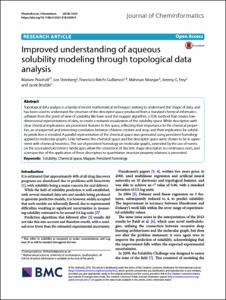Mostra el registre d'ítem simple
Improved understanding of aqueous solubility modeling through topological data analysis
| dc.contributor.author | Pirashvili, Mariam |
| dc.contributor.author | Steinberg, Lee |
| dc.contributor.author | Belchi Guillamon, Francisco |
| dc.contributor.author | Niranjan, Mahesan |
| dc.contributor.author | Frey, Jeremy G. |
| dc.contributor.author | Brodzki, Jacek |
| dc.date.accessioned | 2019-01-31T09:05:19Z |
| dc.date.available | 2019-01-31T09:05:19Z |
| dc.date.issued | 2018 |
| dc.identifier.citation | Pirashvili, M. [et al.]. Improved understanding of aqueous solubility modeling through topological data analysis. "Journal of Cheminformatics", 2018, vol. 10, núm. 54, p. 1-14. |
| dc.identifier.issn | 1758-2946 |
| dc.identifier.uri | http://hdl.handle.net/2117/127959 |
| dc.description.abstract | Topological data analysis is a family of recent mathematical techniques seeking to understand the ‘shape’ of data, and has been used to understand the structure of the descriptor space produced from a standard chemical informatics software from the point of view of solubility. We have used the mapper algorithm, a TDA method that creates low-dimensional representations of data, to create a network visualization of the solubility space. While descriptors with clear chemical implications are prominent features in this space, reflecting their importance to the chemical properties, an unexpected and interesting correlation between chlorine content and rings and their implication for solubility prediction is revealed. A parallel representation of the chemical space was generated using persistent homology applied to molecular graphs. Links between this chemical space and the descriptor space were shown to be in agreement with chemical heuristics. The use of persistent homology on molecular graphs, extended by the use of norms on the associated persistence landscapes allow the conversion of discrete shape descriptors to continuous ones, and a perspective of the application of these descriptors to quantitative structure property relations is presented. |
| dc.format.extent | 14 p. |
| dc.language.iso | eng |
| dc.subject | Àrees temàtiques de la UPC::Informàtica::Aplicacions de la informàtica |
| dc.subject | Àrees temàtiques de la UPC::Enginyeria química::Química física::Dissolucions |
| dc.subject.lcsh | Solubility--drug effects |
| dc.subject.other | Feature extraction |
| dc.subject.other | image classification |
| dc.subject.other | pattern clustering. Chemical space |
| dc.subject.other | Feature selection |
| dc.subject.other | Topological data analysis |
| dc.title | Improved understanding of aqueous solubility modeling through topological data analysis |
| dc.type | Article |
| dc.subject.lemac | Solubilitat |
| dc.identifier.doi | 10.1186/s13321-018-0308-5 |
| dc.description.peerreviewed | Peer Reviewed |
| dc.relation.publisherversion | https://jcheminf.biomedcentral.com/articles/10.1186/s13321-018-0308-5 |
| dc.rights.access | Open Access |
| local.identifier.drac | 23647441 |
| dc.description.version | Postprint (published version) |
| local.citation.author | Pirashvili, M.; Steinberg, L.; Belchi, F.; Niranjan, M.; Frey, J.; Brodzki, J. |
| local.citation.publicationName | Journal of Cheminformatics |
| local.citation.volume | 10 |
| local.citation.number | 54 |
| local.citation.startingPage | 1 |
| local.citation.endingPage | 14 |


